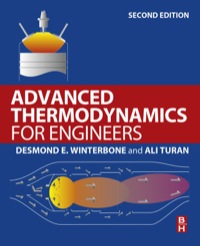A combustible mixture of gas and air is contained in a well-insulated combustion bomb. It is ignited
Question:
A combustible mixture of gas and air is contained in a well-insulated combustion bomb. It is ignited at a point and a thin flame propagates through the mixture completely burning the reactants. This mechanism produces multiple zones of products: prove that the temperature of an element of gas mixture which burned at pressure, \(p_{\mathrm{b}}\), has a temperature, \(T\left(p, p_{\mathrm{b}}\right)\) at a pressure, \(p>p_{\mathrm{b}}\)
\[T\left(p, p_{\mathrm{b}}\right)=\left[T_{1}\left(\frac{p_{\mathrm{b}}}{p_{1}}\right)^{\frac{\kappa-1}{\kappa}}+\frac{Q_{p}^{\prime}}{c_{p}}\right]\left(\frac{p}{p_{\mathrm{b}}}\right)^{\frac{\kappa-1}{\kappa}}\]
where
\(\kappa=\) ratio of specific heats,
\(Q_{p}^{\prime}=\) calorific value of fuel, and suffix 1 defines the conditions before ignition.
Calculate the final pressure, \(p_{2}\), in terms of \(p_{1}, T_{1}, Q_{p}^{\prime}, c_{v}\) and \(\kappa\). What is the difference between the final temperature and that of the first gas to burn if \(T_{1}=300 \mathrm{~K}, \kappa=1.3\) and \(Q_{p}^{\prime} / c v=1500 \mathrm{~K}\).
Step by Step Answer:

Advanced Thermodynamics For Engineers
ISBN: 9780080999838
2nd Edition
Authors: D. E. Winterbone, Ali Turan





